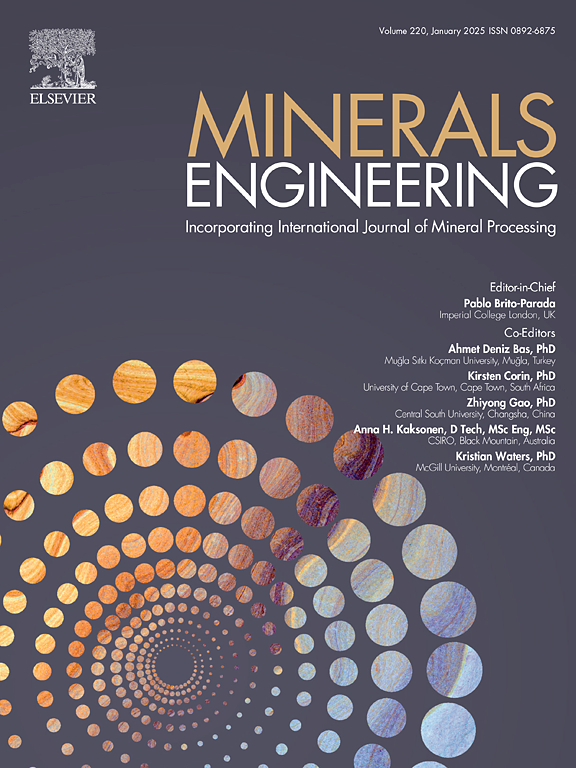Study on the strength improvement mechanism of fine-grained iron tailings cemented backfill after high temperature calcining
IF 5
2区 工程技术
Q1 ENGINEERING, CHEMICAL
引用次数: 0
Abstract
Backfill has become an essential element of underground mining operations around the globe. However, a significant amount of fine-grained tailings can affect the consolidation performance and reduce the strength of backfill. It has been reported that mixing active materials with tailings, while calcining at high temperatures can enhance the gelling activity and strengthen the backfill. To examine the mechanism behind the strength improvement of fine-grained iron tailings cemented backfill following high-temperature calcination, various methods such as uniaxial compression test was used to measure the strength parameter, while laser particle size analysis, XRD and SEM analysis, and thermogravimetric analysis were used to provide a microscopic investigation. The results indicate that the uniaxial compressive strength (UCS) of the samples increased by 596.8 %, from 0.224 MPa to 1.561 MPa after when the tailings were calcine at 800 °C for 2 h and cured for 7 days. Among the mixed calcine groups, the 10 % red mud group showed the most significant effect with UCS of 3.138 MPa after 7 days of curing, showing a 101.0 % higher strength increase than the direct calcine group. Meanwhile, the 20 % red mud mixture showed the highest strength with a UCS of 5.407 MPa, showing a 246.4 % higher strength increase than the direct calcine group. This increase in strength is attributed to the high-temperature calcination, which improved the particle size and increased the number of particles beyond 25 μm. Additionally, the higher temperature calcination caused a dehydroxylation reaction of clinochlore and mica in the tailings, led to the destabilization of the layered chain structure and improved the activity of pozzolanic ash. Furthermore, with the increase of mixed red mud, the dehydroxylation reaction of aluminosilicates occurred at high temperature, and more N-A-S-H gels were generated in the hydration reaction. This created a more stable and compact structure with lower porosity and higher strength in the sample. The findings of this study provide a valuable insight into the large-scale backfill of fine-grained iron tailings in underground stope, as well as reducing the accumulation of fine-grained tailings on the surface.
细粒铁尾矿高温煅烧胶结充填体强度提高机理研究
回填已成为全球地下采矿作业的重要组成部分。然而,大量细粒尾砂会影响充填体的固结性能,降低充填体的强度。有报道称,在尾矿中掺入活性材料,并在高温下煅烧,可以提高充填体的胶凝活性,增强充填体的强度。为探讨细粒铁尾矿胶结充填体高温煅烧后强度提高的机理,采用单轴压缩试验等多种方法对其强度参数进行测量,并采用激光粒度分析、XRD和SEM分析、热重分析等进行细观研究。结果表明:尾矿在800℃下煅烧2 h,养护7 d后,试样的单轴抗压强度(UCS)由0.224 MPa提高到1.561 MPa,提高了596.8%;混合煅烧组中,10%赤泥组效果最显著,养护7 d后的UCS为3.138 MPa,强度比直接煅烧组提高101.0%。与此同时,20%赤泥混合料的强度最高,UCS为5.407 MPa,比直接煅烧组强度提高了246.4%。这种强度的增加是由于高温煅烧改善了颗粒尺寸,增加了25 μm以上颗粒的数量。此外,高温煅烧引起了尾矿中斜沸石和云母的脱羟基反应,导致层状链结构不稳定,提高了火山灰的活性。此外,随着赤泥掺量的增加,铝硅酸盐在高温下发生脱羟基反应,水化反应生成更多的N-A-S-H凝胶。这创造了一个更稳定和紧凑的结构,孔隙率更低,强度更高的样品。研究结果为地下采场细粒铁尾矿的大规模回填以及减少地表细粒尾矿的堆积提供了有价值的认识。
本文章由计算机程序翻译,如有差异,请以英文原文为准。
求助全文
约1分钟内获得全文
求助全文
来源期刊

Minerals Engineering
工程技术-工程:化工
CiteScore
8.70
自引率
18.80%
发文量
519
审稿时长
81 days
期刊介绍:
The purpose of the journal is to provide for the rapid publication of topical papers featuring the latest developments in the allied fields of mineral processing and extractive metallurgy. Its wide ranging coverage of research and practical (operating) topics includes physical separation methods, such as comminution, flotation concentration and dewatering, chemical methods such as bio-, hydro-, and electro-metallurgy, analytical techniques, process control, simulation and instrumentation, and mineralogical aspects of processing. Environmental issues, particularly those pertaining to sustainable development, will also be strongly covered.
 求助内容:
求助内容: 应助结果提醒方式:
应助结果提醒方式:


